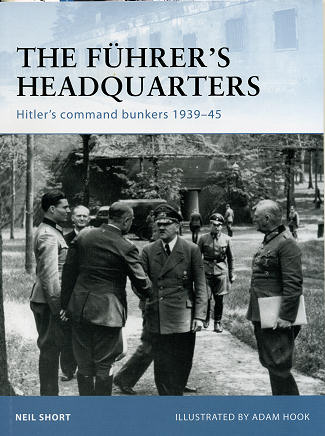 Edition
#100 in Osprey's Fortress series concentrates on the fortifications built to
house Adolf Hitler and his staff during World War II.
Edition
#100 in Osprey's Fortress series concentrates on the fortifications built to
house Adolf Hitler and his staff during World War II.Osprey's The Führer's Headquarters
|
Author: |
Neil Short, illustrated by Adam Hook |
|
Publisher/Distributor |
Osprey Publishing |
|
Price |
$18.95 MSRP |
|
Reviewer: |
|
| Notes: |
64 pages, 7¼ x 9¼
inches, softbound ISBN: 978-1-84603-582-1 |
 Edition
#100 in Osprey's Fortress series concentrates on the fortifications built to
house Adolf Hitler and his staff during World War II.
Edition
#100 in Osprey's Fortress series concentrates on the fortifications built to
house Adolf Hitler and his staff during World War II.
Adolf Hitler was one of those dictators who had to have his hands in on every major military operation that took place during his tenure as leader of the German armed forces. This meant that he needed to be as close to the action as he could get. It also meant that he had to be protected against attack from the other side. This mostly meant attack from the air as Hitler wasn't stupid enough to put himself that close to the front lines.
As a result, it was the job of the Todd Organization to build bomb proof command bunkers for Hitler and his staff. These places had to be well built and in many cases, well camouflaged. They also had to be able to provide sufficient space for meetings as well as provide for the usual services of meals and living quarters.
During and prior to WWII, a total of fourteen structures were built to serve as command bunkers throughout the Third Reich. Since most of them have been destroyed either by the Germans when they left them or by the Allies, a great deal of research has gone into finding the plans for these structures so that we can see what these places looked like and how they were used.
Fortunately, not only have the plans survived, but there have been some of the bunker areas themselves that are still extant. Several of these are in Poland, while one is in Belgium and another in France. None have survived with any degree of completeness in Germany, including the Fuhrer Bunker in Berlin where Hitler took his life (the remains of that were completely buried in 1989).
In this book by Neil Short, we are given a look at all of these structures, where they were built, what the cost was to construct them and how they were used. Thanks to the superlative illustrations by artist Adam Hook, we can see how these places looked and were arranged when they were intact. Thanks to modern photos of those few extant structures, we can get an idea of the massiveness of these places.
In all, it makes for a fascinating look into something that one rarely thinks of when it comes to military history. It is a book I enjoyed reading and can easily recommend to you.
October 2010
For more on the complete line of Osprey books, visit www.ospreypublishing.com. In the US, it is Osprey Direct at 44-02 23rd St, Suite 219, Long Island City, NY 11101., where you can get a catalogue of available books.
If you would like your product reviewed fairly and quickly, please contact me or see other details in the Note to Contributors.